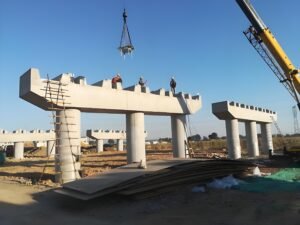Bridges are vital infrastructure components, facilitating transportation and commerce across the globe. Central to their functionality and longevity are bridge bearings. These critical elements ensure that bridges can withstand various forces and movements, maintaining structural integrity and safety. This article explores the different types of bridge bearings, their functions, and their importance in modern bridge construction..
Types of Bridge Bearings
Elastomeric Bearings
Elastomeric bearings are among the most commonly used types in bridge construction. Made from layers of rubber and steel, they provide flexibility and can accommodate movements in multiple directions. These bearings are durable, cost-effective, and easy to install, making them a popular choice for many bridge designs.
Pot Bearings
Pot bearings consist of a metal pot housing a disc made of elastomeric material. They are designed to support heavy loads while allowing rotational movement. Pot bearings are ideal for bridges that experience substantial vertical loads and require rotational flexibility to manage structural movements.
Spherical Bearings
Spherical bearings use a spherical surface to accommodate rotations and tilts in any direction. They are particularly suited for large bridges that undergo significant movements due to thermal expansion, seismic activity, or heavy traffic loads. These bearings ensure smooth operation and longevity of the bridge structure.
Roller Bearings
Roller bearings are used to support large horizontal movements and rotations. They consist of cylindrical rollers placed between two plates, allowing for longitudinal and transverse movements. These bearings are suitable for long-span bridges where horizontal displacement is a critical factor.
Functions of Bridge Bearings
Load Distribution
Bridge bearings play a crucial role in distributing loads from the bridge deck to the substructure. By evenly spreading these loads, bearings help prevent localized stress concentrations, reducing the risk of structural damage and prolonging the bridge’s lifespan.
Accommodating Movements
Bridges are subject to various movements, including thermal expansion, contraction, and seismic activity. Bearings accommodate these movements, ensuring the bridge can expand, contract, and move without compromising structural integrity. This flexibility is essential for the bridge’s durability and functionality.
Reducing Vibration and Noise
Bridge bearings help minimize vibrations and noise generated by traffic loads and environmental factors. By absorbing and dissipating these vibrations, bearings enhance the comfort and safety of bridge users while protecting the structural components from excessive wear and tear.
Importance of Bridge Bearings
Enhancing Safety
Safety is paramount in bridge design, and bearings play a vital role in ensuring it. By accommodating movements and distributing loads, bearings prevent structural failures and enhance the overall safety of the bridge. This is especially important in regions prone to seismic activity or extreme weather conditions.
Extending Service Life
Properly designed and maintained bridge bearings contribute significantly to the longevity of a bridge. By reducing stress on structural components and allowing for controlled movements, bearings help prevent premature wear and damage, ensuring that bridges remain operational for extended periods.
Economic Benefits
Investing in high-quality bridge bearings can result in substantial economic benefits. Reduced maintenance costs, fewer repairs, and extended service life all contribute to lower overall lifecycle costs for bridge infrastructure. This makes bearings a cost-effective solution for maintaining bridge integrity and functionality.
Conclusion
Bridge bearings are indispensable components in modern bridge construction. Their ability to distribute loads, accommodate movements, and reduce vibrations ensures the structural integrity and safety of bridges. By understanding the types, functions, and importance of bridge bearings, engineers and stakeholders can make informed decisions to enhance the performance and longevity of bridge structures. Proper selection and maintenance of bridge bearings are crucial for the continued reliability and safety of our transportation networks.
FAQ
What are bridge bearings?
Bridge bearings are structural devices installed between the bridge deck and the supporting structure to accommodate movements, distribute loads, and reduce vibrations, ensuring the safety and longevity of the bridge.
What types of bridge bearings are there?
The main types of bridge bearings include elastomeric bearings, pot bearings, spherical bearings, and roller bearings, each serving different purposes based on the specific needs of the bridge.
Why are elastomeric bearings popular?
Elastomeric bearings are popular because they are durable, cost-effective, flexible, and easy to install. They can accommodate movements in multiple directions and are suitable for a wide range of bridge designs.
How do pot bearings work?
Pot bearings consist of a metal pot housing a disc made of elastomeric material, designed to support heavy loads while allowing rotational movement. They are ideal for bridges experiencing substantial vertical loads and requiring rotational flexibility.
What is the role of spherical bearings in bridges?
Spherical bearings use a spherical surface to accommodate rotations and tilts in any direction, making them suitable for large bridges with significant movements due to thermal expansion, seismic activity, or heavy traffic loads.
Why are bridge bearings important for safety?
Bridge bearings are crucial for safety as they accommodate movements and distribute loads, preventing structural failures and enhancing the overall safety of the bridge, especially in regions prone to seismic activity or extreme weather conditions.
How do bridge bearings extend the service life of a bridge?
By reducing stress on structural components and allowing for controlled movements, bridge bearings prevent premature wear and damage, contributing significantly to the longevity and functionality of the bridge.
What economic benefits do high-quality bridge bearings provide?
High-quality bridge bearings reduce maintenance costs, minimize repairs, and extend the service life of bridges, resulting in lower overall lifecycle costs for bridge infrastructure, making them a cost-effective solution for maintaining bridge integrity and functionality.
Summary
Bridge bearings are essential for maintaining the structural integrity and safety of bridges. Different types of bearings, such as elastomeric, pot, spherical, and roller bearings, each serve unique purposes in accommodating movements and distributing loads. These bearings play a crucial role in enhancing bridge safety, extending service life, and providing economic benefits by reducing maintenance costs. Understanding the types, functions, and importance of bridge bearings is vital for engineers and stakeholders involved in bridge design and maintenance.



